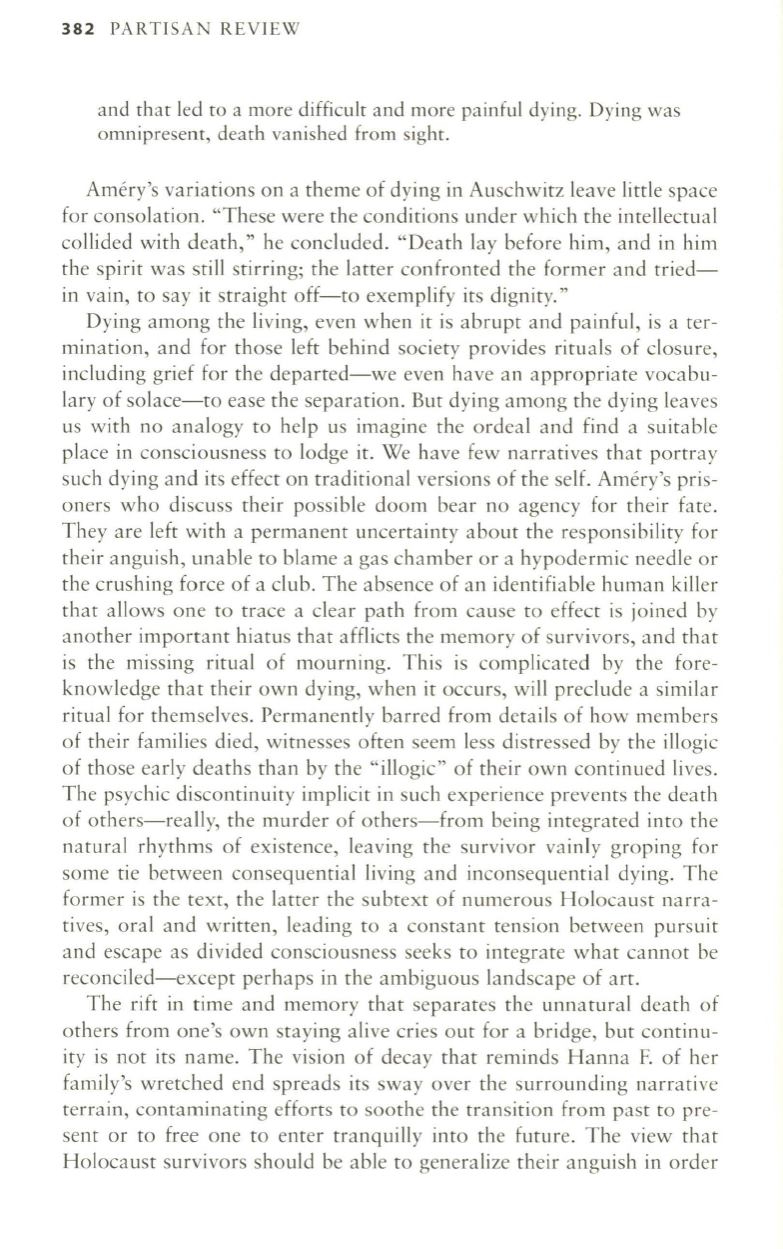
382
PARTISAN REVIEW
and that led to a more difficult and more painful dying. Dying was
omnipresent, death vanished from sight.
Amery's variations on a theme of dying in Auschwitz leave little space
for consolation. "These were the conditions under which the intellectual
collided with death," he concluded. "Death lay before him, and in him
the spirit was still stirring; the latter confronted the former and tried–
in vain, to say it straight off-to exemplify its dignity."
Dying among the living, even when it is abrupt and painful, is a ter–
mination, and for those left behind society provides rituals of closure,
including grief for the departed-we even have an appropriate vocabu–
lary of solace-to ease the separation. But dying among the dying leaves
us with no analogy to help us imagine the ordeal and find a suitable
place in consciousness to lodge it. We have few narratives that portray
such dying and its effect on traditional versions of the self. Amery's pris–
oners who discuss their possible doom bear no agency for their fate.
They are left with a permanent uncertainty about the responsibility for
their anguish, unable to blame a gas chamber or a hypodermic needle or
the crushing force of a club. The absence of an identifiable human killer
that allows one to trace a clear path from cause to effect is joined by
another important hiatus that afflicts the memory of survivors, and that
is the missing ritual of mourning. This is complicated by the fore–
knowledge that their own dying, when it occurs, will preclude a similar
ritual for themselves. Permanently barred from details of how members
of their families died, witnesses often seem less distressed by the illogic
of those early deaths than by the "illogic" of their own continued lives.
The psychic discontinuity implicit in such experience prevents the death
of others-really, the murder of others-from being integrated into the
natural rhythms of existence, leaving the survivor vainly groping for
some tie between consequential living and inconsequential dying. The
former is the text, the latter the subtext of numerous Holocaust narra–
tives, oral and written, leading to a constant tension between pursuit
and escape as divided consciousness seeks to integrate what cannot be
reconciled-except perhaps in the ambiguous landscape of art.
The rift in time and memory that separates the unnatural death of
others from one's own staying alive cries out for a bridge, but continu–
ity is not its name. The vision of decay that reminds Hanna
F.
of her
family's wretched end spreads its sway over the surrounding narrative
terrain, contaminating efforts to soothe the transition from past to pre–
sent or to free one to enter tranquilly into the future. The view that
Holocaust survivors should be able to generalize their anguish in order


